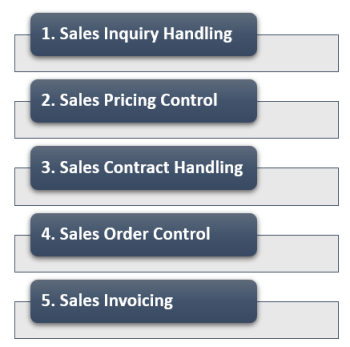ERP Package - Sales Module
In the context of growing market competition, organizations are focusing more on closer partnership across supply chain. Increasing efficiency in sales and distribution process facilitates an organization to maintain its competitive edge. Best practice processes, embedded in an ERP package, are an enabler in this direction.
The important components of sales modules:
- Sales inquiry handling.
- Sales pricing control.
- Sales contract handling.
- Sales order control.
- Sales invoicing.
Integration with other modules: Sales module is a highly integrated execution module. It draws most of its input from the following modules:
- Inventory module for verifying available and projected stock.
- Production module for production schedules and lead time of delivery.
- Purchasing module for generation of direct delivery purchase order.
- Warehousing module for issuing order and shipment.
- Accounts receivable module where sales invoices are recorded.
- Distribution requirement planning under planning module for just in time delivery and supplying to channels partners.

- Sales enquiry handling functionality
- Margin Control: Margin control is based on cost price, standard sales price or retail price. The system verifies if the price quoted is as per allowable margin. Allowable margin may be configured to vary from user to user, whereby an user with higher level of authorization may confirm a transaction which was disallowed by the system for a user with lower level of authorization.
- Quotation is made in response to enquiry from a customer. Quotation may be created for a standard or customized item. Terms of payment is suggested by the system from the credit rating of the customer and delivery date is obtained from the Available to Promise (ATP) data of inventory module. Price and discount amount for each item of the quotation may be obtained automatically from price book. If the quotation is successful, it is processed for generation of sales order. If the quotation is unsuccessful, the reason of failure and name of successful vendor are recorded in the system for future reference.
- Sale Pricing Control
Sales pricing control helps to maintain prices for items, details of discount structure and special discount given to some category of customers such as Original Equipment Manufacturer (OEM).
A price book originates with base price for the item. A single level discount rule with a minimum or maximum quantity or pricing break, is attached to price book. Additional pricing conditions such as category of suppler, delivery schedule etc. may be formulated in a matrix format, for attaching to the price book.
- Sales Contract Handling: This process relates to recording long term agreement with customer for price, discount, delivery etc.
Normally, a validity period and minimum committed quantity forms part of the contract. Cumulative called quantity by the customer, delivered quantity and invoiced quantity are maintained in the system for control purpose. The easy way of making a contract for existing customer is by copying an old contract and doing modification in the system.
For a new customer, data related to header and lines are entered in the requisite session. The system helps in evaluating the contract at any given time, and customer may be reminded for any failure to meet their part of commitment.
- Sales Order handling: This process allows a company to manage sales operations quickly and efficiently. This process handles regular sales order, cost order, customer return and collect order.
Through use of templates, the system allows quick data entry process to manage products ranging from standard to Engineering to Order (ETO). On time ATP helps in identifying when a product is available for delivery and making necessary commitment/allocation for the same. Rebate and commission process enables automatic calculation of commission to be paid to sales employees and channel partners.
- Sales invoicing: This process facilitate billing functions such as issuing of invoices based on goods/services provided, generating proforma invoices, issuing credit notes resulting corresponding entries in accounts receivable and control account of general ledger.
Conclusion
Functions of sales module is now augmented by various extended ERP products such as Customer Relationship Management (CRM) and several collaborative tools. E- Commerce has created a new channel for sales and distribution. Sales functionality now looks beyond ERP.
| ❮❮ Previous | Next ❯❯ |
 Related Articles
Related Articles
- Supply Chain & Distribution Planning
- Order based Planning
- Setting Up Service Module
- Planning, Warranties and Contracts
- Call Handling & Service Orders Control
Authorship/Referencing - About the Author(s)
The article is Written and Reviewed by Management Study Guide Content Team. MSG Content Team comprises experienced Faculty Member, Professionals and Subject Matter Experts. We are a ISO 2001:2015 Certified Education Provider. To Know more, click on About Us. The use of this material is free for learning and education purpose. Please reference authorship of content used, including link(s) to ManagementStudyGuide.com and the content page url.